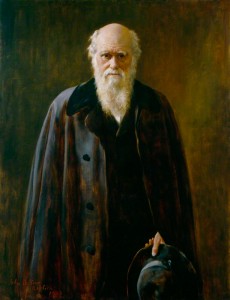We’ve been watching the Chelsea Flower Show on telly. A display of orchids reminded me of this painting, which I identified for my friends at Cider House Galleries earlier this year. The sitter, shown in his hothouse, is Edward Cox (1809 – 1879), Serjeant-at-Law, magazine entrepreneur, legal publisher, a Victorian Richard Branson with his fingers in many pies.
It was painted by the Hon John Collier, signed and dated 1878, a painter best-known for his portraits of intellectual heavyweights like Charles Darwin (National Portrait Gallery),

(c) NPG
though he also painted Victorian erotica like this extraordinary picture of the enchantress Circe who changed men into beasts.
Location unknown. Image (c) Art Magick
Collier began as a pre-Raphaelite, inspired by Sir Lawrence Alma-Tadema; the orchids in his Portrait of Edward Cox are a superb exercise in the high-keyed palette and vivid detail of the pre-Raphaelites.
The painting was acquired as ‘portrait of an unknown man’ but thanks the NPG Archive which has a copy of Collier’s sitter book donated by his son, and Serjeant Cox’s reputation as an orchid grower, he has been reidentified, and has joined an appropriate collection. It is especially satisfying because this is the only-known oil portrait of Serjeant Cox; he is known otherwise from a woodcut print published with his obituary in 1879.
Val Micklewright and Dr Henry Oakeley, Secretary and President of the Orchid Society, gave me very generous help in my research. Collier’s painting is so accurate that Dr Oakley was able to identify the orchids:
‘The orchids that Cox is holding are Cattleya purpurata or C. lawrenceana with more of the same on the plant in front of him (the plant is mounted on a thick sheet of cork bark), the white spray of flowers at the bottom middle is Odontoglossum crispum (now renamed Oncidium alexandrae); the red one at bottom left corner is probably Masdevallia ignea, above it are three flowers of Cattleya mossiae semi-alba. Just to the right of the topmost of these three flowers is a flower of Lycaste deppei. Above his head is Cyrtochilum macranthum (known as Oncidium macranthum from 1833-1917).’
This quarter’s Orchid Society of Great Britain Journal has an article on the identification of the portrait, with Dr Oakeley’s notes on the orchids and his superb photographs of modern examples.
Serjeant Cox’s orchids were his passion, and he spent a fortune on them. One lot in his posthumous sale sold for the equivalent of £1,300 today. This was a hobby he could well afford. He was one of the great publishers of the Nineteenth Century. He had started the Western Gazette (still going strong in his native Somerset) while still in his twenties. When he came to London kick-started legal journalism and magazine publishing from his offices at 364 the Strand: he founded the Law Times, and Exchange and Mart; relaunched The Field in its current form and co-founded Crockford’s Clerical Directory. That is just the titles which still survive. And all this while practising law, and campaigning for then-radical Bar reforms like making it compulsory for barristers to have legal training.
(c) English Heritage
Then the other week, while we were watching Timothy Spall in the dramatisation of the 1970s poltergeist case, The Enfield Haunting, I was reminded of another string to Serjeant Cox’s bow, an interest as great as his love of orchids. In 1875 he founded the Psychological Society. And since what we would call the science of psychology was inseparable back then from the study of spiritualism, he spent a lot of time investigating mediums and seances. After his death, some members of the Society would form the Society for Psychical Research, the same body that investigated the poltergeist in Enfield a hundred years later. Serjeant Cox was a sceptic and made a particular study of mediums’ tricks. What he would have made of the Enfield poltergeist I don’t know. I must read about some of the cases he investigated.




